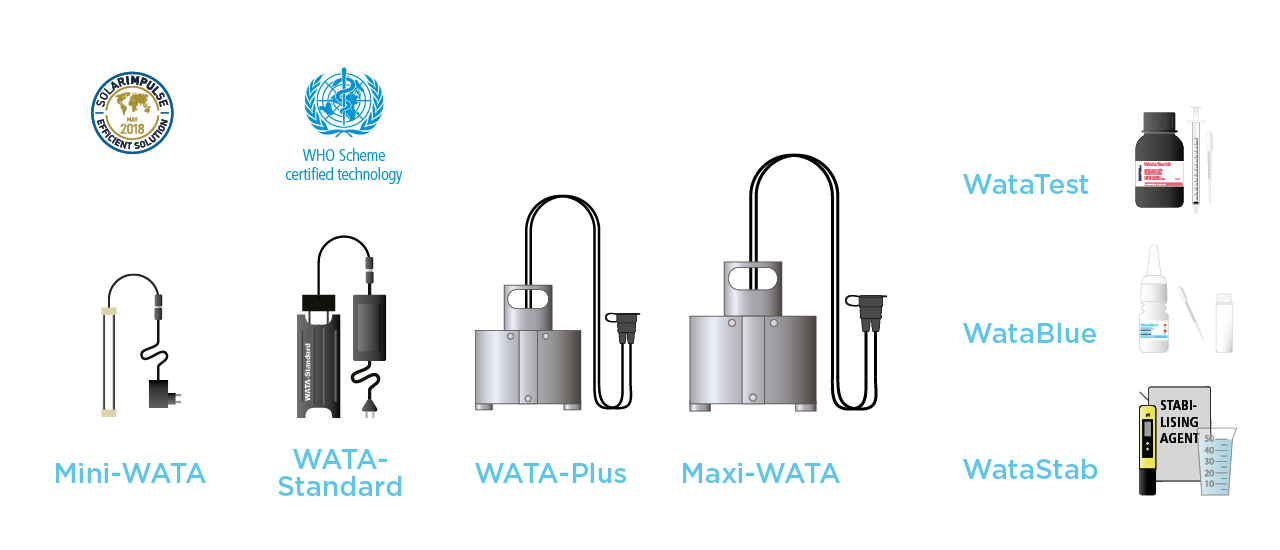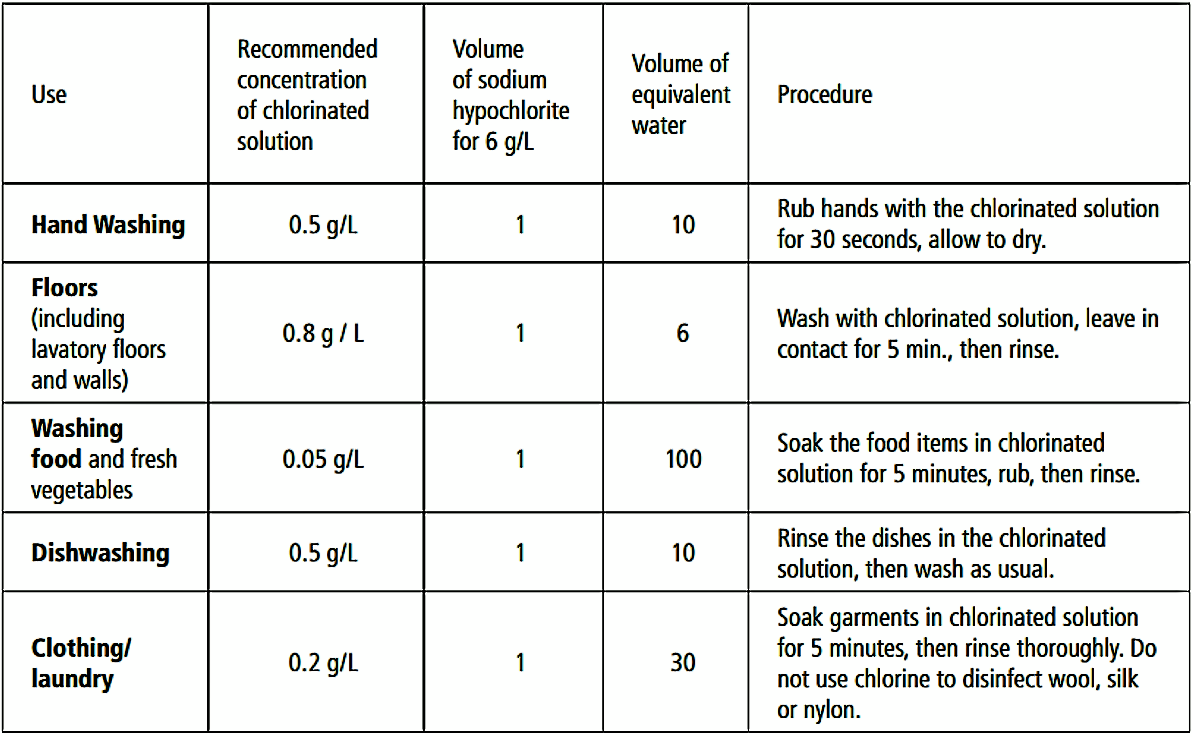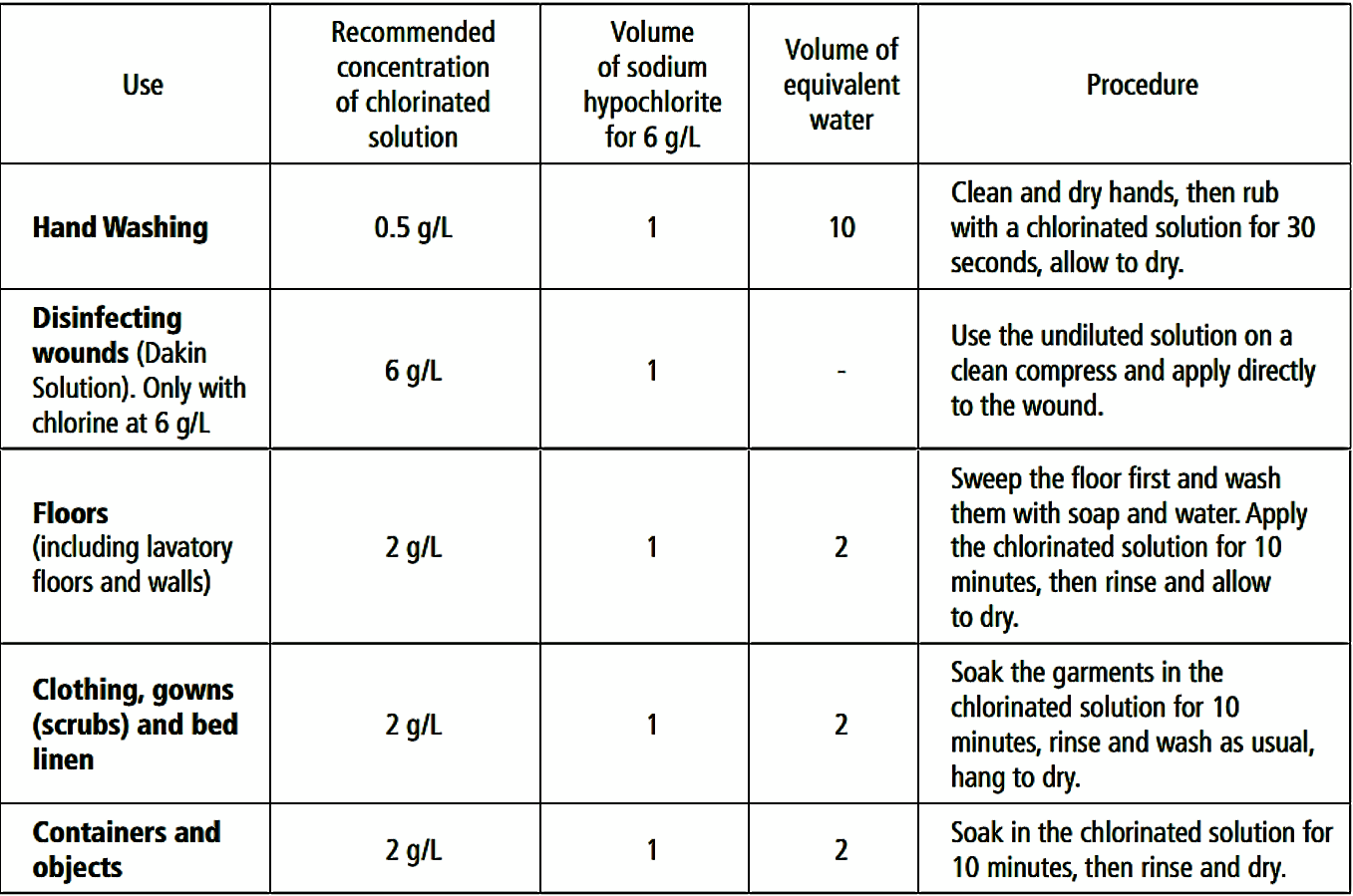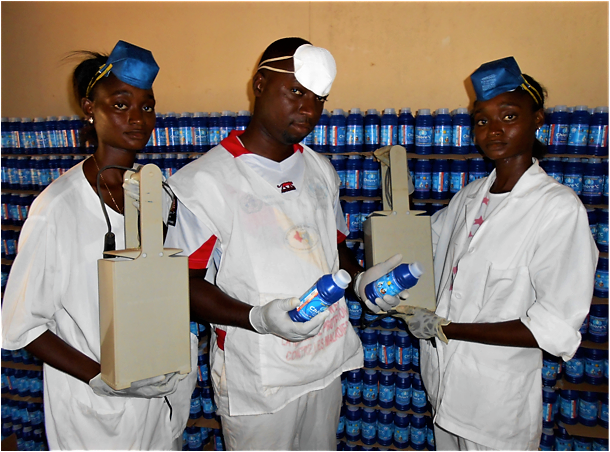Executive Summary
Chlorination, which means adding active chlorine (sodium hypochlorite) to water, is the most common method used for disinfecting of drinking water. Active chlorine destroys or inactivates most pathogenic microorganisms, including parasites, bacteria and viruses with a very high reliability. The WHO estimates that chlorination is the most secure, effective and economic option. Yet, generally speaking, chlorine is not produced in low-income countries, but imported in the form of tablets or bleach, at relatively high cost. WATA™ is a technology which has initially been developed by Antenna Foundation which integrates health education with the local production of chlorine by electrolysis (through the WATA™ device) in a sustainable supply chain, making safe water treatment a profitable activity. WATA technology is now sold and promoted by the social company WATALUX SA.
| In | Out |
|---|---|
Drinking Water |
Introduction
To prevent waterborne diseases it is fundamental to deliver safe water at the point of use. The 2017 published Joint Monitoring Programme (JMP) report from WHO and UNICEF shows that recontamination occurs very often between the point of collection and the point of use and thus leads to an increase in waterborne diseases. It is thus fundamental to find a solution to enable populations to address their drinking water problem in a self-sufficient and perennial way. To respond to the need of BoP communities to have access to simple and affordable water treatment methods at the household level, WATALUX proposes a range of WATA devices (Mini-WATA™, WATA-Standard™, WATA-Plus™ and Maxi-WATA™), and control reagents (the WataBlue™ & WataTest™). Until today WATA™ kits have been used in over 100 countries.

WATA™ devices
The WATA™ is a handy, robust device designed specifically for the production of active chlorine through the electrolysis of salted water under conditions in developing countries. The resulting solution can be used for drinking water disinfection (1 Liter of chlorine per 3´300 Liters of contaminated water) since the strong oxidising power of the chlorine will destroy most of the pathogenic germs and the water will be drinkable after 30 minutes.
WATATECHNOLOGY (2020)
This sodium hypochlorite solution can also be used as a disinfectant for home use. The WATA™ system is extremely adaptable to meeting the disinfectant needs of larger institutions such as health facilities also. Additionally, the sodium hypochlorite solution is similar to Dakin’s solution, a neutral disinfectant, and can be used directly for cleaning wounds.
Use of WATA™


The device requires only water, salt and electricity to function. It is important to note that clear water is a requirement for both the production process and as an input for the disinfection process. For the production process, highly turbid water will interfere with the electrolysis process and the resulting solution may not be at 5g of active chlorine per liter. If the turbidity (a measure of the suspended solids in the water) of the water to be disinfected exceeds 5 units of turbidity (NTU), it could diminish the treatment’s efficiency and not guarantee adequate inactivation of microbes. If highly turbid water is the only source available, the suspended solids need to be removed, for example by (cloth) filtration, sedimentation or flocculation. The WATA™ is appropriate for urban and rural areas and foster people’s autonomy where the technology is implemented. Since the WATA™ devices need a reliable electricity supply to operate, the Mini-WATA™, WATA-Standard™ and the WATA-Plus™ are designed to be easily powered with solar energy with dedicated solar kits supplied by WATALUX.
Production of the Sodium Hypochlorite Solution using the WATA-Standard™
Preparation of the Saturated solution: The user first prepares salt water at 25g NACl/Liter. The WATA™ device needs to be immersed in the salt water and connected to a reliable source of electricity. The salt water is converted into sodium hypochlorite solution with a 5 g/L concentration of active chlorine through a process known as electrolysis. Potentially contaminated water can be made potable by adding a small dose of chlorine (5 mL chlorine per 20 L water). Despite the simplicity of operating a WATA™ device, the production of active chlorine and disinfection of potable water for a community is a responsibility, and thus requires skilled people as operators, specially trained and dedicated for that purpose.

Preparation of the solution for use of the electrolyser: Using a large syringe (50 mL), add 160 mL of the saturated solution per 2 L of water to be electrolysed. Then continue to fill your container with clear water (total volume 2 L).
Testing the solution after the installation and connection of the WATA-Standard:
WataTest™ and WataBlue™ reagents are part of the WATA™ kits and allow the user simple onsite water quality control. WataTest™ and WataBlue™ are non-toxic and inexpensive reagents which are used to measure the active chlorine concentration of sodium hypochlorite and free residual chlorine in the water, respectively. Free residual chlorine (FRC) is important because sufficient levels are required to ensure adequate inactivation of microbes and to guarantee the residual effect that chlorine has of preventing the recontamination of water during handling or consumption. Since increasing levels of FRC makes the water taste and smell unappealing, the WHO recommends a level of FRC between 0.2 and 0.5 ppm in order to strike a balance between disinfection and water taste and smell. 0.5 ppm is the level of FRC that the WHO recommends as striking the balance between effective disinfection and acceptability in terms of taste and smell. The. WataBlue™ allows the user to carry out a safe and systematic quality control of the treated drinking water to ensure that this level is reached.

Maintenance
Devices need to be rinsed after each procedure with clean water. Since 2018, a production controller performs 2 key assets:
- Timer: it stops the electrolysis when the process is done
- Polarity reversal: it cleans the electrodes and prevents the operator to clean the device.
Storage
Properly used, well maintained and carefully stored after each use, WATA™ devices are designed to operate for a minimum of 10,000 operating hours, meaning not less than 5 years of use. Active chlorine is very sensitive to light. It is therefore very important to store the solution produced with the WATA™ devices in closed and opaque, non-metallic recipients and label it with the production date. Place the container in a cool place, out of reach of children. Do not expose it to sunlight. The sodium hypochlorite should be used within 24 hours as the concentration of active chlorine will decline if the solution is not stabilized.
WATA™ application and business models
Our objective is to make safe water treatment a profitable activity for communities of developing countries. In the long run, the production and sale of chlorine should create an income generating activity for the local population and ensure their independence in water treatment. The cost for one litre of active chlorine concentrate stands at US$ 0.05.
WATA™ is more than a device, it can be combined with health education, technical training, and the creation of an economic model based on sodium hypochlorite and chlorinated water production and sales. Making safe water treatment a profitable activity while insuring autonomy.
Several dissemination models have been tested and approved in the field:
- Through health centres: The WATA™ device can produce, at a very low-cost, the large quantity of quality disinfectant needed to ensure hygiene standards in health facilities. This reduces nosocomial diseases and decreases mortality during childbirth. In addition, the sodium hypochlorite solution can be used as an effective, low-cost wound disinfectant (Dakin’s solution).
- Through economic structures (i.e. women’s groups, salesperson in kiosks, pharmacies): Direct chlorine sales or disinfection of drinking water, with subsequent sale at kiosks or home delivery, using the chlorine produced by the WATA™ device creates an income-generating activity;
- Through school structures: One WATA™ device can ensure that the school’s supply of drinking water is disinfected and be a source of disinfectants to clean floors, surfaces and latrines. They also create an opportunity for promotional and awareness activities around the themes of safe drinking water and sanitation;
- Through water user associations and water utilities: As an autonomous chlorine generator, the WATA™ device can substitute for other chlorinated products in regions where chlorine gases and powders are under embargo, as in armed conflict areas.
To appropriately implement WATA™ devices in your specific environment it is recommended to design and test the implementation, pilot it together with the users and customers, adapt and amend the dissemination strategy and the respective business model in order to scale-up and replicate the successful approaches that have been pioneered with the WATA™ devices.
Wata Technology Products and Services
Buy a range of devices that will enable you to produce chlorine locally. URL [Accessed: 18.03.2021]
Antenna Foundation – Water & Hygiene
Antenna Foundation, a Geneva-based Swiss Foundation dedicated to develop and disseminate technologies for essential needs of the most vulnerable people around the world, presents its activities including the WATA® devices and provides the reader with background information about safe water and hygiene.
ANTENNA FOUNDATION (2017): Antenna Foundation – Water & Hygiene. Geneva: Antenna Foundation URL [Accessed: 10.08.2017]WATA - Operating Manual
WATA-Standard
Safely managed drinking water - thematic report on drinking water 2017
The Joint Monitoring Programme (JMP) for Water Supply and Sanitation’s report examines the SDG vision for universal access to water and sanitation. New ‘ladders’ for monitoring drinking water services at home, at school and in health facilities are presented, together with proposals for enhanced monitoring of inequalities and affordability in order to progressive elimination of inequalities and global progress towards SDG target 6.1.
WHO (2017): Safely managed drinking water - thematic report on drinking water 2017. Geneva: World Health Organisation URL [Accessed: 25.07.2017]International Scheme to Evaluate Household Water Treatment Technologies
WHO established the international scheme to evaluate HWTS. The Scheme aims to consistently and independently evaluate the performance of HWTS against WHO performance recommendations. The report provides the result of these assessments from a range of HWT technologies including solar, chemical, filtration and ultraviolet (UV). It highlights that of the ten HWT products evaluated, eight were found to meet WHO performance recommendations. The report also recommends specific actions at the national level needed to ensure that health gains from HWT are realized, including strengthening regulation and evaluation of HWTS.
WHO (EDITOR) (2016): International Scheme to Evaluate Household Water Treatment Technologies. Geneva: World Health Organisation URL [Accessed: 20.04.2018]AUTARCON SuMeWa System
Powerpoint presentation of the water purification system implied by AUTARCON. This system uses solar energy to realise mechanical filtration and chlorification of water.
AUTARCON (2012): AUTARCON SuMeWa System. SolarPV Driven-Drinking Water Treatment. Munich: AUTARCON, Sun Meets Water (SuMeWa) System. [Accessed: 18.07.2017] PDFMarketing Safe Water Systems: Why it is so hard to get safe water to the poor – and so profitable to sell it to the rich
This book provides unique insights – from the varied perspectives of users, disseminators, producers and retailers – into the marketing challenges of point-of-use water treatment devices.
HEIERLI, U. (2008): Marketing Safe Water Systems: Why it is so hard to get safe water to the poor – and so profitable to sell it to the rich. Bern: Swiss Agency for Development and Cooperation (SDC) URL [Accessed: 18.05.2019]Promotion of household water treatment and safe storage in UNICEF WASH programmes
Short introduction to household water treatment and the main treatment methods.
UNICEF (2008): Promotion of household water treatment and safe storage in UNICEF WASH programmes. pdf presentation. New York: United Nations Children's Fund URL [Accessed: 17.03.2010]Preventing Diarrhoeal Disease in Developing Countries: Proven Household Water Treatment Options
One-page introduction to main household water treatments methods, and further reading links.
CDC/USAID (2008): Preventing Diarrhoeal Disease in Developing Countries: Proven Household Water Treatment Options. Atlanta and New York: Center for Disease Control and Prevention (CDC) and United States Agency for International Development (USAID) URL [Accessed: 15.03.2010]Filtration & Chlorination Systems
Introduction to filtration and chlorination systems at the household level.
CDC/USAID (2009): Filtration & Chlorination Systems . (= CDC Household Water Treatment Options in Developing Countries Factsheets ). New York: Center for Disease Control and Prevention (CDC) and United States Agency for International Development (USAID). [Accessed: 01.04.2010] PDFScaling Up Household Water Treatment Among Low-Income Populations
This report examines the evidence to date regarding the scalability of HWTS. It seeks to consolidate existing knowledge and experience and distil the lessons learnt. Its primary aims are to 1) review the development and evolution of leading household water treatment technologies in their efforts to achieve scale, 2) identify the main constraints that they have encountered and 3) recommend ways forward.
CLASEN, T.D. (2009): Scaling Up Household Water Treatment Among Low-Income Populations. (PhD Thesis). Geneva: World Health Organization (WHO) URL [Accessed: 09.04.2010]Household water treatment and safe storage in emergencies
This document is intended as a general manual on household water treatment and storage in emergencies. Methods of treatment but also promotion are presented, including factsheets, a decision tree and very comprehensive illustrations.
IFRC (2008): Household water treatment and safe storage in emergencies. pdf presentation. Geneva: International Federation of Red Cross and Red Crescent Societies (IFRC) URL [Accessed: 23.04.2012]Smart Disinfection Solutions
This booklet, part of the Smart Water Solutions series provides a wide range of methods and products for home water treatment in rural areas.
NWP (2010): Smart Disinfection Solutions. Examples of small-scale disinfection products for safe drinking water. (= Smart water solutions ). Amsterdam: KIT Publishers URL [Accessed: 17.05.2019]Water, sanitation and Hygiene interventions to combat childhood diarrhoea in developing countries
This document provides a review of the effectiveness of interventions in the water, sanitation and hygiene (WASH) sector in promoting better health outcomes in developing countries, as measured by the incidence of diarrhoea among children.
WADDINGTON, H. SNILSTEIT, B. WHITE, H. FEWTRELL, L. (2009): Water, sanitation and Hygiene interventions to combat childhood diarrhoea in developing countries. (= Synthetic review, 001 ). New Delhi: International initiative for Impact Evaluation (3IE) URL [Accessed: 18.05.2019]Guidelines for Drinking-water Quality, Fourth Edition
This volume of the Guidelines for Drinking-water Quality explains requirements to ensure drinking-water safety, including minimum procedures and specific guideline values, and how those requirements are intended to be used. The volume also describes the approaches used in deriving the guidelines, including guideline values. It includes fact sheets on significant microbial and chemical hazards.
WHO (EDITOR) (2011): Guidelines for Drinking-water Quality, Fourth Edition. Geneva: World Health Organization (WHO) URL [Accessed: 11.07.2018]Drinking water chlorination
This 8-pages information paper highlights chlorine’s critical role in providing safe drinking water; the potential health and environmental effects of chlorine and disinfection by-products; and considerations for selecting disinfection methods.
WORLD CHLORINE COUNCIL (2008): Drinking water chlorination. Position Paper URL [Accessed: 18.05.2019]Conservation et Traitement de l Eau a Domicile
This practical guide provides a review of different processing techniques and adequate water conservation at home and is structured around 10 key questions that should be posed before choosing a suitable solution.
DESILLE, D. (2013): Conservation et Traitement de l Eau a Domicile. Paris: Programme Solidarite Eau (PSeau) URL [Accessed: 06.06.2013]Antenna Foundation – Water & Hygiene
Antenna Foundation, a Geneva-based Swiss Foundation dedicated to develop and disseminate technologies for essential needs of the most vulnerable people around the world, presents its activities including the WATA® devices and provides the reader with background information about safe water and hygiene.
ANTENNA FOUNDATION (2017): Antenna Foundation – Water & Hygiene. Geneva: Antenna Foundation URL [Accessed: 10.08.2017]Range of WATA® Devices
The instruction sheet provides detailed information of how to install and use the WATA® devices in different contexts. It highlights precautions to be made and provides additional information about the production and use of sodium hypochlorite.
Wata Technology Products and Services URL
ANTENNA FOUNDATION (2017): Range of WATA® Devices. Geneva: Antenna Foundation URL [Accessed: 10.08.2017]Chlorination and safe storage of household drinking water in developing countries to reduce waterborne disease
This study evaluated point-of-use chlorination and storage in special plastic containers of gathered household water for improving microbial quality and reducing diarrhoeal incidences among consumers living under conditions of poor sanitation and hygiene.
SOBSEY, M.D. ; HANDZEL, T. ; VENCZEL L. (2003): Chlorination and safe storage of household drinking water in developing countries to reduce waterborne disease. In: Water Science and Technology: Volume 47 , 221-228. URL [Accessed: 18.05.2019]PV Meets Drinking Water
This article describes the practicability of a water purification system which is not reliant on batteries but on solar radiation.
WIDMAN, M. (2011): PV Meets Drinking Water. In: pv magazine: Volume 12 URL [Accessed: 16.07.2012]WATA Tutorials
Promoting hygiene and water treatment to prevent deadly diseases in Guinea
In response to a severe cholera outbreak in 2006, UNICEF has partnered with Tinkisso, a local NGO in the region of Dabola that produces active chlorine with WATA devices.
WASH Cluster Coordination Project
A complete WASH Cluster Hygiene Promotion training package.
Pedag-eau (Virtual library)
Awareness raising material on water, sanitation and hygiene (only available in French).
WATA, a simple solution for disinfection and water treatment
User guide for WATA kit and quality control reagents.
Chloration de l'eau de boisson avec WATA
This video explains how to produce active chlorine with WATA devices. FRENCH
Potabiliation de l'eau et désinfection avec WATA
This video explains how to use active chlorine produced with the WATA device for drinking water, disinfection and cleaning. It explains also how to use the tests to control disinfection and residual chlorine concentrations. FRENCH
Operating instructions WATA and reagents
This website provides general information on chlorine and its different uses, WATA devices (user guides) and quality control reagents as well as on the WATASOL approach and its implementation around the world.
Press review
This internet link presents the WATA press release and various articles on WATA and the WATASOL approach.
The WATA device
Akvopedia is an open water and sanitation resource and provide information on production of active chlorine with WATA devices.
Chimie de l´eau de javel
This website in French is a host of information on chlorine. FRENCH
Effect of Chlorination on Inactivating Selected Pathogen
This site describes the effect of chlorination on inactivating selected pathogens.
300in6 - a strategic centre for safe water scale-up
300in6 is an initiative to provide 300 million people with safe drinking water in 6 years with a focus on home water treatment options that include chorine.
WATA Range
Full range of WATA® devices are presented under this link. The different performances of the chlorinating devices are highlighted and applicability emphasized.
Safe Water Phase 2
The blog entry describes a 3-year safe water initiative led by Antenna Foundation to facilitate market based business approaches in safe water that do partly build around the application of WATA® devices.
Antenna Technologies' mission illustrated
Short video describes Antenna Foundation’s core approach of scientific resarch of technological, health and economic solutions to meet essential needs of marginalized populations around the globe.
Water Treatment with WATA
Treatment de l´eau avec la solution WATA --> Link
Water treatment with the WATA solution --> Link
https://www.youtube.com/watch?v=5T88Me6ZNcA Treatment de l´eau avec la solution WATA . [Accessed: 24.03.2021]Hospital Disinfection
Wata dans les centres de santés --> Link
Wata in healthcare facilities --> Link
https://www.youtube.com/watch?v=obiAyB9aayA [Accessed: 24.03.2021]
